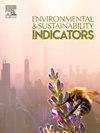Climate extreme indices and its implication on crop production: The case of Mana district, Jimma Zone, Southwest Ethiopia
IF 5.4
Q1 ENVIRONMENTAL SCIENCES
引用次数: 0
Abstract
Climate change is manifesting globally, with its effect on agricultural productivity becoming more apparent. There is no doubt that climate change is already affecting the economic development of developing countries. This research utilizes 40 years of historical climate data (1981–2021) to analyze temperature and rainfall trends and extreme climate indices in Mana district of Jimma zone in south-western Ethiopia. The significance level of temperature and rainfall trends and climate extreme indices were detected using Mann-Kendall's test statistics and the RClimDex, respectively. The study revealed that monthly maximum value of daily maximum temperature (TXx) and monthly minimum value of daily maximum temperature (TXn) experienced a statistically significant increasing trend (P < 0.05). The results also revealed that the mean maximum temperature ranged from 21 to 32 °C, while the average minimum temperature varied between 10.9 and 14.23 °C. Conversely, none of the rainfall trends and extreme indices demonstrated statistical significance. Results reveal that warm nights, warm days, and diurnal temperature ranges were experienced an increasing trend, which have tremendous impacts on crop production. Further studies should be conducted using climate data from multiple stations to measure the impacts of climate extremes on crop yield, which can give a tangible evidence for policymakers to design climate change adaptation and mitigation strategies.
气候极端指数及其对作物生产的影响——以埃塞俄比亚西南部吉马区马纳区为例
气候变化正在全球范围内显现,其对农业生产力的影响日益明显。毫无疑问,气候变化已经影响到发展中国家的经济发展。本研究利用40年的历史气候数据(1981-2021)分析了埃塞俄比亚西南部吉马地区马纳地区的温度和降雨趋势以及极端气候指数。采用Mann-Kendall检验统计量和RClimDex分别检测温度和降雨趋势和气候极端指数的显著性水平。研究发现,月最高气温最大值(TXx)和月最低气温最小值(TXn)呈显著上升趋势(P <;0.05)。平均最高气温在21 ~ 32℃之间,平均最低气温在10.9 ~ 14.23℃之间。相反,降雨趋势和极端指数均不具有统计显著性。结果表明,暖夜、暖日、暖温差均呈增加趋势,对作物生产有较大影响。应利用多个站点的气候数据开展进一步研究,以衡量极端气候对作物产量的影响,这可以为决策者设计气候变化适应和减缓战略提供切实证据。
本文章由计算机程序翻译,如有差异,请以英文原文为准。
求助全文
约1分钟内获得全文
求助全文
来源期刊

Environmental and Sustainability Indicators
Environmental Science-Environmental Science (miscellaneous)
CiteScore
7.80
自引率
2.30%
发文量
49
审稿时长
57 days
 求助内容:
求助内容: 应助结果提醒方式:
应助结果提醒方式:


